football training drills pdf
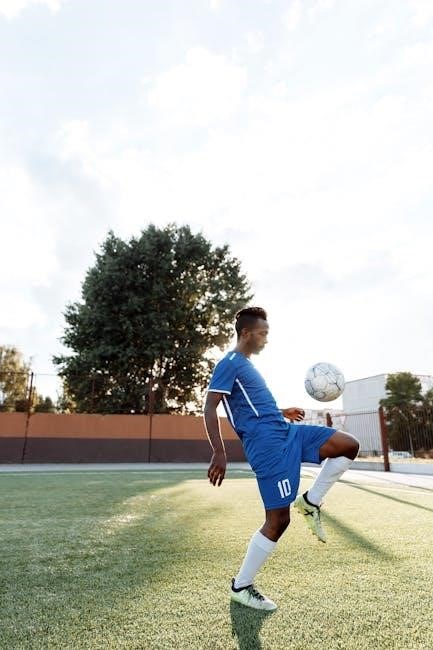
Football training drills are structured exercises to enhance agility‚ ball control‚ and teamwork‚ providing a comprehensive approach to improving player skills and overall game performance effectively․
Overview of the Importance of Structured Training
Structured training is essential for football development‚ as it ensures consistency‚ skill improvement‚ and teamwork․ It helps players build neuromuscular control‚ coordination‚ and communication․ A well-planned approach maximizes efficiency‚ preparing athletes for game scenarios‚ tactics‚ and strategies․ Training drills promote progressive learning‚ allowing players to master foundational skills before advancing to complex techniques․ This systematic method ensures each session addresses specific goals‚ fostering overall performance․ Structured training also enhances mental focus‚ discipline‚ and adaptability‚ enabling players to excel in competitive environments while maintaining motivation and engagement throughout the season․
How to Choose the Right Drills for Your Team
Selecting the right drills involves assessing your team’s skill level‚ identifying specific needs‚ and aligning with seasonal goals․ Start by evaluating player fitness‚ technical abilities‚ and tactical awareness․ Choose drills that address weaknesses and build on strengths․ Consider the age group and experience of players to ensure exercises are appropriate․ Mix foundational skills‚ like ball control‚ with advanced techniques‚ such as positional play․ Incorporate drills that promote teamwork and communication․ Use progressive training plans to gradually increase complexity․ Ensure drills are engaging and varied to maintain motivation․ Always prioritize safety and adapt exercises to suit available resources and time constraints․
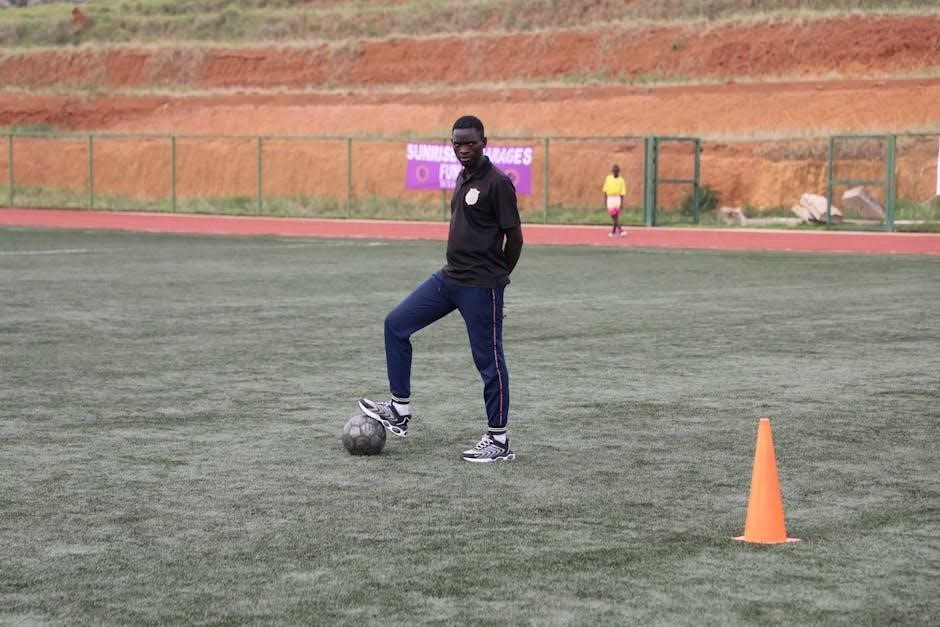
Warm-Up and Flexibility Drills
Dynamic stretching and agility circuits prepare players for training‚ improving flexibility and coordination․ These drills enhance muscle readiness and reduce injury risk while boosting overall performance levels․
Dynamic Stretching Exercises
Dynamic stretching exercises are essential for football warm-ups․ Players perform movements like leg swings‚ arm circles‚ and torso twists to prepare for physical exertion․ These exercises increase blood flow and reduce muscle stiffness․ They are designed to mimic football movements‚ such as high knees‚ lunges‚ and side shuffles‚ ensuring players are ready for drills․ Dynamic stretches improve flexibility and coordination‚ helping athletes avoid injuries while enhancing performance․ Coaches often include these exercises at the start of training sessions to ensure players are fully prepared for the intensity of practice and competition․ Proper execution of these stretches ensures optimal readiness and reduces the risk of muscle strains․
High-Intensity Interval Training (HIIT) for Football
High-Intensity Interval Training (HIIT) is a powerful tool in football training‚ combining short bursts of intense effort with brief recovery periods to boost cardiovascular fitness‚ speed‚ and endurance․ These drills are designed to mimic the demands of a match‚ improving players’ ability to perform at maximum capacity over prolonged periods․ Examples include sprints‚ shuttle runs‚ and cone drills․ HIIT enhances anaerobic and aerobic systems‚ making players more resilient during games․ Coaches often incorporate HIIT into sessions to simulate real-game scenarios‚ ensuring players are prepared for the physical and mental challenges of competition․ This method is highly effective for improving overall football performance and stamina․ Regular HIIT sessions can lead to significant improvements in player endurance and speed‚ making it a key component of modern football training programs․ HIIT also promotes mental toughness and focus‚ helping players maintain peak performance levels under pressure․ By integrating HIIT into drills‚ coaches can ensure players are physically and mentally prepared for the demands of the game․ This training approach is versatile and can be adapted to suit different fitness levels and team objectives‚ ensuring optimal results for all players․
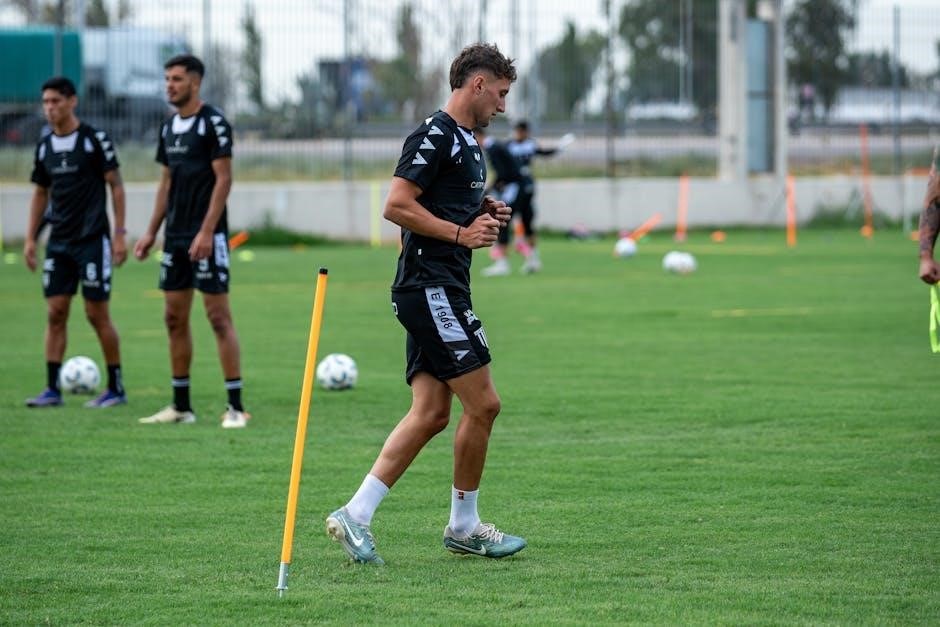
Ball Control and Dribbling Drills
Ball control and dribbling drills enhance a player’s ability to maintain possession and navigate the field effectively‚ using techniques like zig-zagging through cones and hopping over hurdles․
Stationary Ball Control Techniques
Stationary ball control techniques focus on improving a player’s ability to manipulate the ball without movement․ These drills enhance touch‚ precision‚ and focus․ Players practice figure-eights around cones‚ inside-outside touches‚ and sole rolls․ Such exercises build confidence and mastery of the ball‚ allowing players to control it effortlessly in game situations․ Proper body positioning and ankle movement are emphasized to maintain control․ These techniques are fundamental for any player aiming to excel in dribbling and ball possession․ Regular practice of these drills ensures improved ball control‚ which is crucial for effective playmaking and maintaining possession during matches․
Zig-Zag Dribbling Through Cones
Zig-zag dribbling through cones is a dynamic drill that enhances agility‚ foot speed‚ and ball control․ Players weave the ball through a series of cones arranged in a zig-zag pattern‚ focusing on quick changes of direction and precise touches․ This exercise improves coordination and balance while maintaining possession of the ball․ Coaches often vary the distance between cones and the height of the zig-zags to increase difficulty․ Players are encouraged to keep their heads up‚ stay low‚ and use the inside and outside of their feet to maneuver the ball․ Regular practice of this drill helps develop the ability to beat defenders in tight spaces during matches․
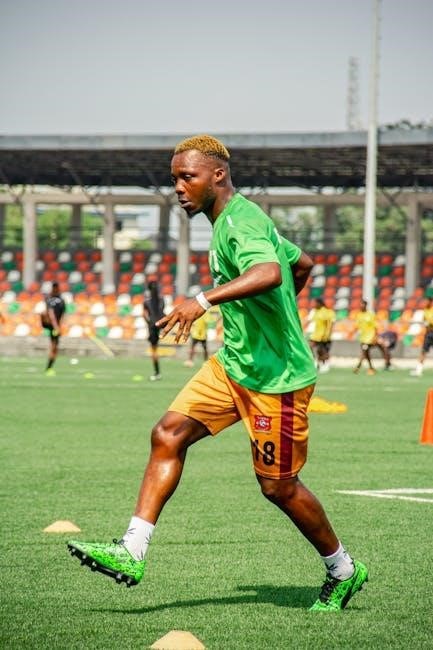
Passing and Receiving Drills
Passing and receiving drills focus on accuracy‚ movement‚ and control‚ essential for maintaining possession and creating scoring opportunities during matches․ Wall passes and throw-in practices are key components․
Short and Long Passing Accuracy Exercises
Short and long passing drills are fundamental for improving accuracy and control․ Players pair up‚ starting with short‚ ground passes‚ gradually increasing distance to test precision․ Accuracy is stressed‚ encouraging players to weight their passes appropriately․ Variations include wall passes and throw-ins‚ simulating game scenarios․ These exercises enhance teamwork and ball distribution skills‚ essential for maintaining possession and creating scoring opportunities during matches․ Coaches emphasize proper technique and movement to ensure effective execution․ Regular practice of these drills builds consistency and confidence in players’ ability to deliver precise passes under pressure․
Wall Pass and Throw-In Practices
Wall pass and throw-in drills are essential for improving first-touch quality and decision-making․ Players practice wall passes immediately after receiving a ball from a throw-in‚ simulating game scenarios․ Variations include one-twos‚ layoffs‚ and diagonal passes to test accuracy and control․ Coaches emphasize the importance of precise ball placement and movement off the ball․ These exercises enhance teamwork‚ spatial awareness‚ and the ability to maintain possession under pressure․ Regular practice helps players develop quick reactions and effective communication‚ crucial for seamless transitions during matches․ The drills are progressive‚ starting with basic techniques and advancing to more complex combinations‚ ensuring comprehensive skill development․
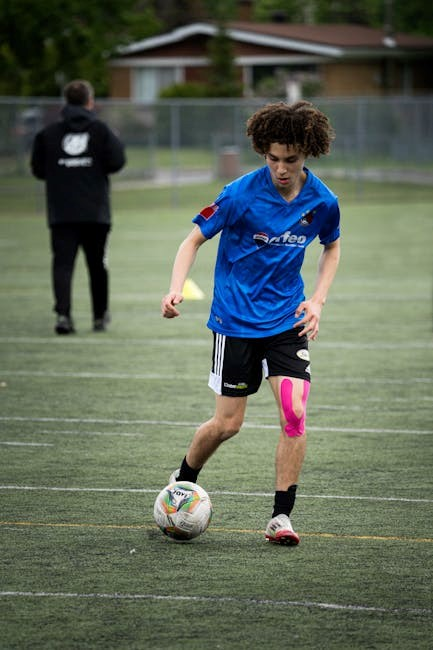
Shooting and Finishing Drills
Shooting and finishing drills focus on technique‚ power‚ and precision․ Players practice breakaways‚ one-on-one scenarios‚ and volleys to improve accuracy and composure in front of goal․
Technique for Power and Precision Shooting
Mastering shooting technique is essential for effective goal scoring․ Players should focus on proper body positioning‚ ensuring balance and stability․ Striking the ball with the laces or the side of the foot enhances power‚ while using the inside of the foot improves accuracy․ Emphasize follow-through to maintain control and direction․ Drills should include shooting from various distances and angles‚ incorporating breakaway scenarios to simulate game situations․ Partner drills‚ where one player crosses the ball and another finishes‚ can enhance timing and composure․ Repetition and focused practice are key to developing consistency and confidence in front of the goal․
Breakaway and One-on-One Scenarios
Breakaway and one-on-one drills simulate real-game scenarios‚ focusing on speed‚ decision-making‚ and finishing under pressure․ Players sprint toward the goal‚ using agility and ball control to outmaneuver defenders․ These exercises improve reaction time and composure in high-stakes situations․ Coaches can vary the setup by adding cones or obstacles to increase difficulty․ Drills often involve a goalkeeper‚ challenging players to accurately place shots in corners or use clever moves to deceive․ Emphasizing precision and confidence‚ these scenarios help players master the art of scoring in isolated attacking opportunities‚ enhancing their ability to capitalize on counterattacks and individual breaks during matches․
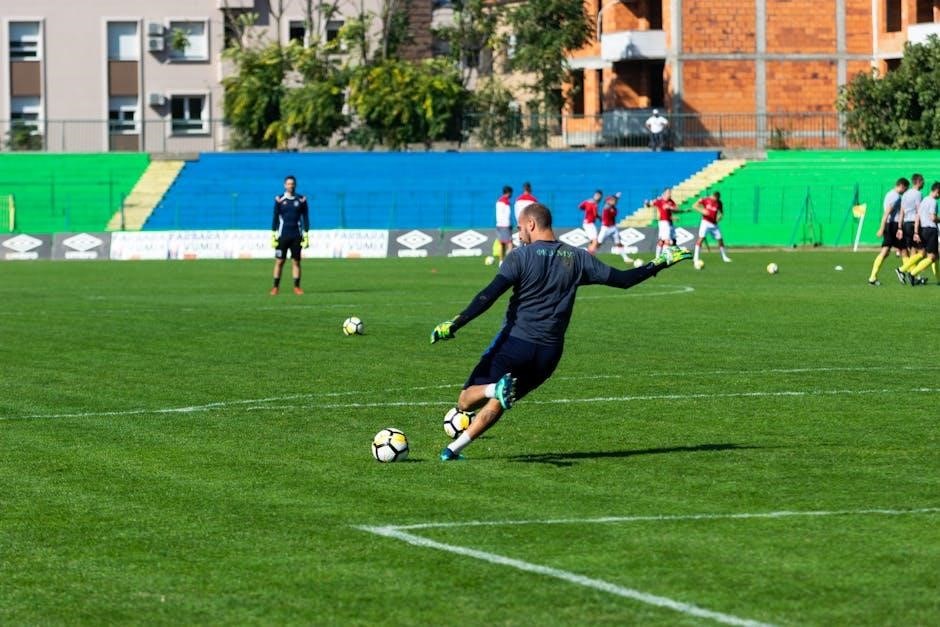
Agility and Speed Drills
Agility and speed drills enhance quick footwork‚ balance‚ and acceleration‚ using cone exercises‚ ladder drills‚ and hurdle hops to improve players’ ability to rapidly change direction and sprint effectively․
Cone Drills for Quick Footwork
Cone drills are essential for improving agility‚ balance‚ and rapid movements in football․ Players weave through cones in zig-zag patterns or circular paths‚ enhancing foot speed and precision․ These exercises can be customized with varying distances and layouts to challenge athletes․ Incorporating ladder drills alongside cones adds complexity‚ focusing on quick stepovers and lateral shuffles․ Proper technique‚ such as keeping knees bent and staying low‚ ensures optimal performance․ Coaches often combine cone drills with ball control to simulate game scenarios‚ making training dynamic and effective․ Regular practice improves coordination‚ reaction time‚ and the ability to change direction swiftly during matches․
Hurdle Hops and Ladder Exercises
Hurdle hops and ladder exercises are key components of football agility training‚ designed to enhance foot speed‚ coordination‚ and overall lower-body explosiveness․ Players perform lateral shuffles‚ high knees‚ and quick stepovers through ladders to improve precision and rhythm․ Hurdle hops challenge athletes to jump over barriers‚ developing power and balance․ These drills are often combined with ball control exercises to simulate game-like movements․ Coaches emphasize proper form to prevent injuries and maximize benefits․ Regular practice of these exercises boosts agility‚ enabling players to execute sharp turns and rapid accelerations on the field․ They are fundamental for refining coordination and reaction time in dynamic football scenarios․
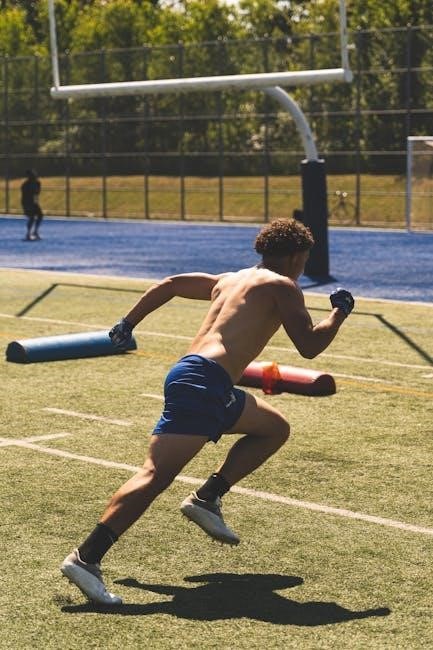
Defensive Drills
Defensive drills focus on enhancing positioning‚ tackling‚ and coordination‚ equipping players to anticipate opponents’ moves and maintain defensive shape effectively during matches․
Positioning and Tackling Techniques
Positioning and tackling are critical defensive skills that require precision and timing․ Players learn to anticipate opponents’ movements‚ ensuring optimal defensive positioning․ Proper tackling techniques‚ such as staying balanced and using the correct foot‚ are emphasized to safely win the ball․ Drills focus on improving spatial awareness and reaction speed‚ enabling defenders to intercept passes and disrupt attacks effectively․ These exercises also help build confidence in one-on-one situations‚ fostering a proactive defensive mindset․ By mastering these techniques‚ players enhance their ability to protect the goal and maintain defensive stability during matches․
Defensive Shape and Coordination
Defensive shape and coordination are vital for maintaining a solid backline and protecting the goal․ Drills focus on improving communication‚ spatial awareness‚ and synchronized movements among defenders․ Players learn to maintain compact defensive lines‚ reducing gaps opponents can exploit․ Exercises such as 8v8 training games and small-sided scrimmages help refine defensive transitions and adaptability․ These drills emphasize the importance of anticipation‚ ensuring defenders are proactive rather than reactive․ By fostering a cohesive unit‚ players develop the ability to adjust their positioning based on the flow of the game‚ creating a resilient and organized defensive structure that minimizes vulnerabilities and maximizes collective strength․
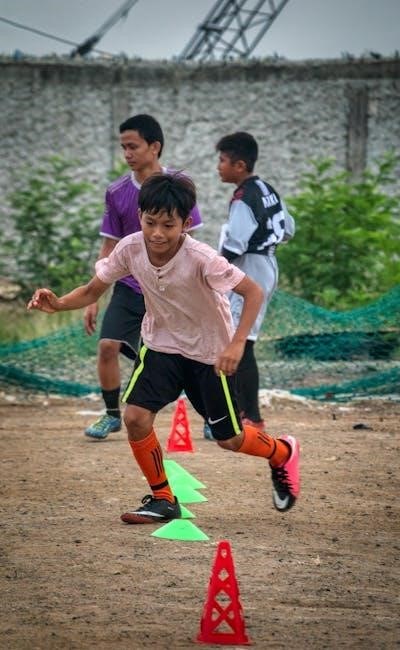
Goalkeeping Drills
Goalkeeping drills focus on enhancing reflexes‚ handling‚ and distribution skills․ Practices include diving exercises‚ high-ball catches‚ and accurate throws‚ ensuring keepers are confident and effective in all situations․
Handling and Distribution Practices
Handling and distribution drills are crucial for goalkeepers to master․ These exercises focus on improving glove work‚ catching technique‚ and accurate throws․ Practices include high-ball catches‚ diving drills‚ and distribution accuracy․ Goalkeepers learn to effectively handle crosses and distribute the ball to teammates․ These drills enhance reflexes and decision-making‚ ensuring confident performance during matches․ By incorporating varied handling scenarios‚ keepers build the skills needed to command the box and initiate plays effectively․ Regular practice ensures sharp reflexes and precise distribution‚ making goalkeepers indispensable to the team’s success․ These drills form the foundation of a goalkeeper’s training regimen․

Small-Sided Games
Small-sided games like 3v3 and 4v4 scrimmages maximize player involvement and decision-making․ They enhance ball control‚ spatial awareness‚ and teamwork in a dynamic‚ competitive environment effectively․
3v3 and 4v4 Scrimmage Variations
3v3 and 4v4 scrimmages are versatile drills that emphasize teamwork‚ ball control‚ and spatial awareness․ In a reduced field setup‚ players engage in fast-paced‚ dynamic matches‚ fostering quick decision-making and tactical awareness․ These games encourage creativity and problem-solving while maintaining high-intensity activity․ Coaches can adjust rules‚ such as offside restrictions or specific scoring zones‚ to focus on particular skills․ Players benefit from increased touches on the ball and enhanced communication‚ making these drills ideal for improving game intelligence and physical fitness simultaneously․ They are adaptable to various skill levels and age groups‚ ensuring an effective and engaging training experience for all participants․

Progressive Training Plans
Progressive training plans involve structured drills that gradually increase in complexity‚ focusing on specific skills and adapting to player development‚ ensuring continuous improvement and adaptability in football training․
Building Complexity in Drills
Building complexity in football drills involves gradually incorporating advanced techniques and scenarios to challenge players․ Starting with basic exercises like ball control and passing‚ coaches can introduce variables such as defensive pressure‚ limited space‚ or time constraints․ For example‚ drills like zig-zagging through cones while dribbling or performing precise long passes under pressure enhance both skill and decision-making․ Additionally‚ integrating multi-player interactions‚ such as 1v1 or small-sided games‚ simulates real-match conditions․ Coaches should tailor drills to the team’s skill level‚ ensuring a smooth progression from simple to complex tasks․ This approach fosters adaptability and prepares players for dynamic game situations effectively․
Effective football training drills enhance player development‚ fostering skill mastery‚ teamwork‚ and adaptability․ Consistent practice with structured‚ engaging sessions ensures continuous improvement and success on the field․
Maximizing the Effectiveness of Training Sessions
To maximize training effectiveness‚ coaches should design structured‚ engaging sessions that progress in difficulty․ Start with dynamic warm-ups and incorporate drills like zig-zag dribbling and cone exercises to enhance agility and ball control․ Small-sided games‚ such as 3v3 or 4v4 scrimmages‚ promote decision-making and teamwork․ Ensure each player has a ball when possible to maximize touches and repetition․ Vary drills to maintain engagement and adapt them to suit different skill levels․ Encourage communication and focus on specific coaching points‚ like accurate passing and shielding techniques․ Ending with fun activities ensures a positive finish‚ keeping players motivated and eager for the next session․
Leave a Reply
You must be logged in to post a comment.